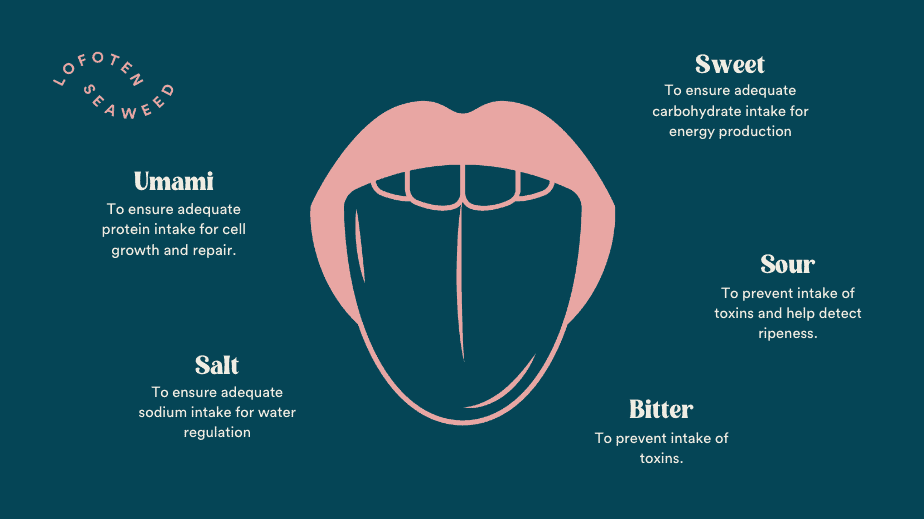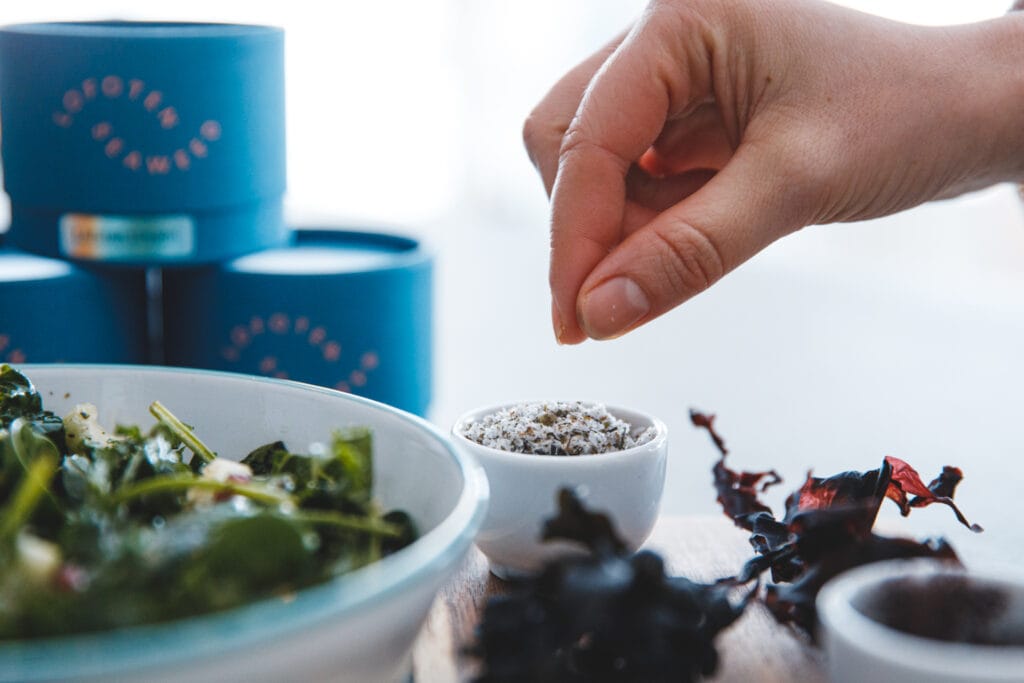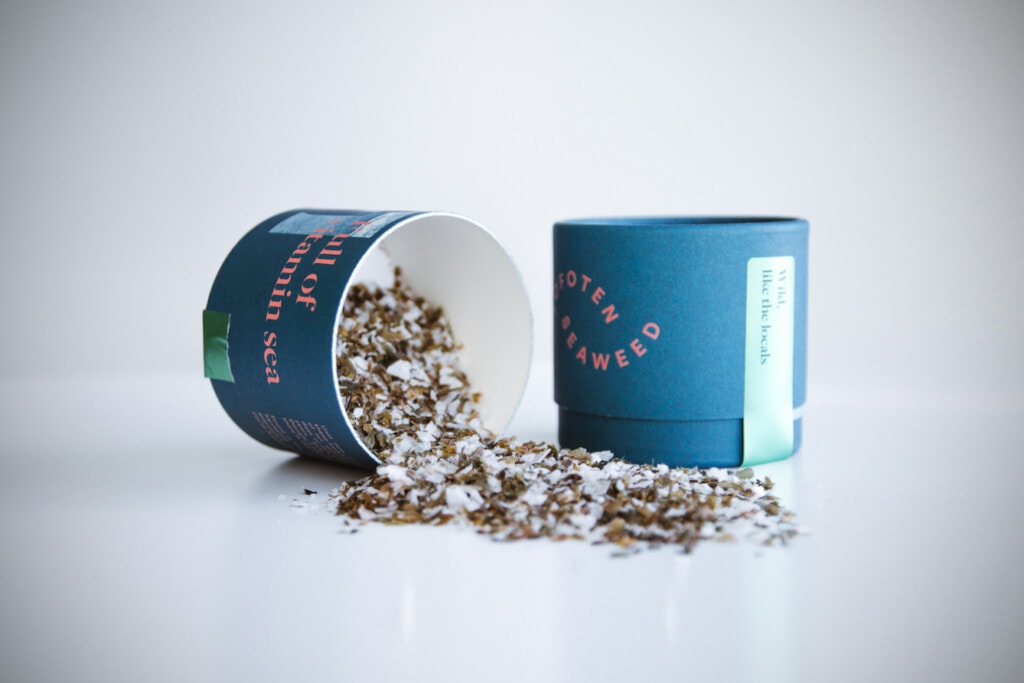Which type of salt should you be using?
Did you know that there are over ten different types of edible salt on the market today? Each with a different provenance, appearance, taste and price tag? With so much choice, it can be tricky to know where to start. However, when used correctly, salt is one of the most useful tools in the cook’s arsenal! When armed with a little information, it’s easy to make healthy, mindful choices with your salt intake, and that’s where we can help. In this article, we’ll dive a little deeper into all things salt; the pros, the cons, the various types, and why we think seaweed salt beats them all…
The five tastes
Conventional wisdom used to state that the human tongue consisted of receptors that responded to different tastes, and that these were located in different parts of the tongue, for example, sweet taste receptors at the tip of the tongue, and sour at the back. This view has since evolved, and we now know that all our tastebuds can respond to the five tastes – salt, sweet, sour, bitter and umami – with varying levels of sensitivity. We also know that we can manipulate overall flavour by blending contrasting tastes, for example, a sour lemon in a bitter gin and tonic, or a pinch of salt in a sweet caramel sauce.
The five tastes aren’t just for our enjoyment though! Scientists believe that we developed each taste receptor as part of our evolutionary development, as a way of signalling minerals that the body needed to survive – or ones that it needed to avoid…

Why do we use salt?
Salt is described as a universal flavour enhancer. In low concentrations it suppresses bitterness, and increases sweet, sour and umami, which makes it great for desserts. In higher concentrations it suppresses sweetness and enhances umami – fantastic for savoury dishes. It’s also widely available in its pure form, easy to use and cost-effective.
Salt is a chemical compound (electrolyte) made from roughly 40% sodium and 60% chloride. The human body uses salt to retain and regulate fluid and mineral levels in the body, as well as to conduct nerve impulses and contract muscles. Our diets are already sodium-rich, so we don’t need to worry about sodium supplements or adding extra salt. In fact, although there is no official toxic dose of sodium, there is an upper tolerable limit of 6g per day for adults.
The average person gets around 75% of their daily sodium allowance through processed foods, many of which have high levels of sodium that the average consumer may not even be aware of, as well as other undesirable qualities like high calorific content and low nutritional density. To maintain healthy levels of sodium it’s a good idea to avoid too much processed food, and be mindful of the salt that you add yourself to your meals.
Salt has also been used as a preserving agent for thousands of years, long before modern refrigeration:
Salt is effective as a preservative because it reduces the water activity of foods. The water activity of a food is the amount of unbound water available for microbial growth and chemical reactions. Prior to refrigeration, salt was one of the best methods for inhibiting the growth and survival of undesirable microorganisms. Although modern-day advances in food storage and packaging techniques and the speed of transportation have largely diminished this role, salt does remain in widespread use for preventing rapid spoilage (and thus extending product shelf life), creating an inhospitable environment for pathogens, and promoting the growth of desirable micro-organisms in various fermented foods and other products.
https://www.ncbi.nlm.nih.gov/books/NBK50952/
We still use salt as a preservative to this day. Fermented foods like sauerkraut, kimchi and miso are all made by submerging base ingredients in a saline solution which at the same time suffocates bad bacteria and promotes good, gut-healthy bacteria. Cured meat and fish are also made using salt as a binding agent. In this recipe for gravlax for example, the salmon is coated in salt, which draws the water from the flesh over 36 hours, removing the possibility of microbial activity, and leaving behind a deliciously cured piece of fish.
Which type of salt is best?
Rock salt
Rock salt is mined in its solid form, and can contain many trace minerals depending on the strata from which it was collected. This can lead to variations in colour, flavour, and texture. For example, pink Himalayan salt is found in mines under the Himalayas, and has a pinkish hue due to the presence of iron oxide in the area. Persian blue salt, from the Iranian mountains, contains high levels of the mineral sylvinite, which gives it its unique blue tones. These are examples of two rare and highly-prized rock salts – most rock salts are far more common, and cheaper! Rock salt is available to buy in its coarse form for all sorts of culinary purposes.
Table salt
To produce table salt, rock salt is highly processed to remove impurities. Trace minerals are often removed as part of this processing, and in order to get a fine, free-flowing table salt, anti-caking agents are often added to avoid clumping. Table salt is sometimes fortified with iodine, to address the iodine deficiencies that can be found in many Western diets. This is something that we know quite a bit about, as seaweed is a fantastic natural source of iodine.

Sea salt
Extracted by evaporating sea water, sea salt goes through far fewer processes than table salt or even rock salt. It’s generally seen as a more natural alternative for this reason. The flavour profile of sea salt can vary depending on where it was extracted from – for example, Celtic salt comes from the waters along the coasts of Brittany, and has a distinctive grey colour, with a slightly moist texture, and briny flavour. Because of its unrefined nature, sea salt is coarse and tactile, forming beautiful crystals as it dries.
Seaweed salt
Seaweed salt is typically a blend of sea salt and dried, milled flakes of seaweed. Seaweed has naturally high levels of both umami and iodine, as well as a whole host of other trace minerals which it effectively absorbs from the ocean. This means it provides a boost in both flavour and nutrition! Our seaweed salts contain a careful mix of sea salt and seaweed flakes, which means that with each teaspoon you’re consuming less salt, without compromising on taste.
Seaweed salt can vary in appearance and flavour depending on the concentration of seaweed, and the type of seaweed used. We make most of our seaweed salts with winged kelp, which is a dark leafy green when dried, and brownish when smoked. Our truffle seaweed salt is slightly purple in hue, with its distinctive taste and aroma of truffles.
Ultimately, there’s no right or wrong choice when it comes to choosing which type of salt to use – they each have their place in the cooking process. In our humble opinion, seaweed salt is the purest, most natural source of the minerals you need for a healthy body – and it packs a huge amount of flavour as well. Have a browse through our range of seaweed salts, or if you’re feeling ready to ditch the salt altogether, you could try our pure seaweed flakes!


